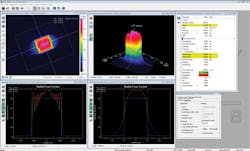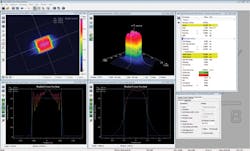Research and development: IR cameras measure laser beam profiles
In the last decade, the requirements of telecommunications vendors to transmit larger amount of data at higher speeds has risen dramatically, requiring the deployment of optical transmission methods. In fiber optic-based network technology, light with wavelengths of 1,300nm and 1,550nm have prevailed, since the light loss over fiber optics is the lowest at these values.
To feed source signals into the fiber optic cable with as little loss as possible, telecommunications companies use electro-optical transceivers that employ InGaAsP or GaAs LEDs that are then coupled to the fiber. To ensure that such optical data transmission systems are as efficient as possible, radiation scattering loss must be minimized and different LED/incidence angles must be avoided when the LED is coupled to the cable. With a fiber diameter of approximately 6μm, bundling and directing the beam so that the coupling efficiency is optimal, represents a challenge.
To overcome this, telecommunications companies use laser beam profilers to measure the beam radius and its shape. These beam profilers are used to provide a qualitative impression of a beam profile that can provide data to properly align the laser. Additionally, measurements of the beam radius at different locations along the beam axis allow beam quality to be characterized. Live measurements of these parameters allow telecommunications providers to continually calibrate the beam and to optimize performance.
In developing its beam profilers, CINOGY Technologies (Duderstadt, Germany; www.cinogy.com) uses IR cameras from Allied Vision (Stadtroda, Germany; www.alliedvision.com) that employ InGaAs sensors. "In the short-wave IR range, beam profilers based on InGaAs sensors are especially well suited for laser measurement since CCD and CMOS-sensors can only be used for wavelengths up to 1100nm. However, cameras based on InGaAs sensors expand the measurable wavelength range to 1700nm," says Andy Kaemling, Managing Director of CINOGY Technologies.
CINOGY installs either the Allied Vision Goldeye G-008 SWIR (320 x 256 pixels) or the Goldeye G-033 SWIR (640 x 512 pixels) IR camera in the laser beam profiler, depending upon the resolution required. Both models use a SWIR InGaAs FPA sensor and are sensitive within the 900-1700 nm range. The cooled sensors inside the camera increase its sensitivity, even with long exposure times.
In operation, the laser beam is pointed directly onto the InGaAs sensor. Data from the camera is then transferred over a Gigabit Ethernet interface for analysis. This is performed using CINOGY Technologies RayCi software that enables continual monitoring of beam parameters. If there are undesired structures in the beam, the laser profile displays signal loss. To measure performance stability, values are measured over a defined time period and compared.
Laser profile parameters are visualized in various ways that reproduce the form and distribution of the beam. Color-graded scales highlight the different characteristics.
For remote software control, the software offers an XML-RPC interface for remote software control. For example, RayCi can be controlled using LabVIEW applications from National Instruments (Austin, TX, USA; www.ni.com), scripts or Microsoft Excel. Dynamic Link Libraries (DLL) are also available that allow integration into specific applications.

